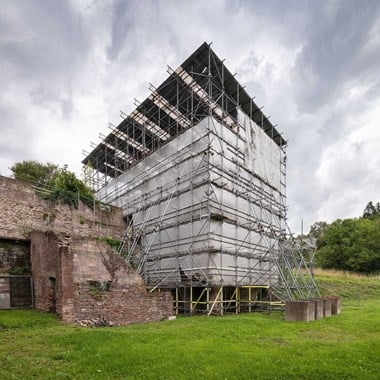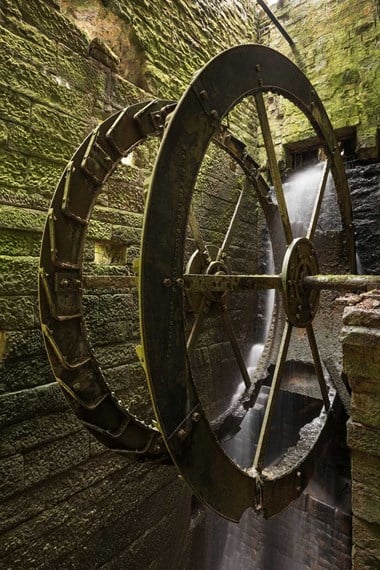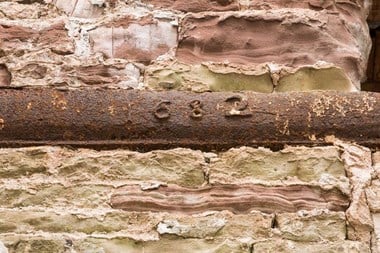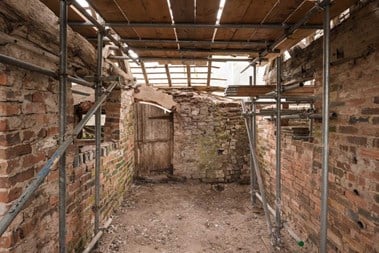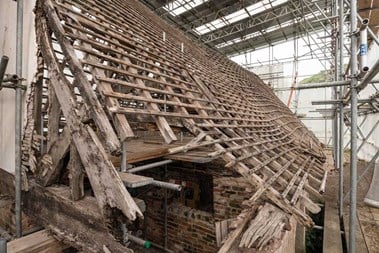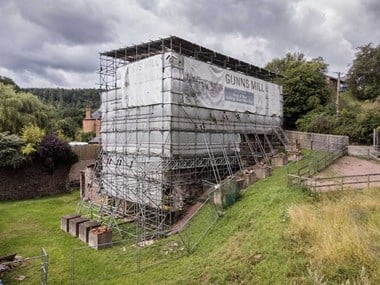Planning the Repair of Gunns Mill, Forest of Dean, Gloucestershire
Historic England has awarded a grant of £31,020 to the Forest of Dean Building Preservation Trust to help plan the repair of Gunns Mill furnace, one of Britain’s most important industrial heritage sites.
The grant is enabling architects and engineers to design a structural solution to repair the timber frame of the roof of the bridge house and provide a usable space inside.
The bridge house once protected the charcoal and ore from the weather before loading into the furnace. It is the only surviving bridge house for a furnace of this type and adds to Gunns Mill’s national importance.
The Trust intend to repair Gunns Mill and find a sustainable new use so that it can be enjoyed and understood in the future.
Once the architects and engineers have prepared a solution, we will fundraise for the work to be undertaken. This is a major step forward in the journey of this building and would mean that we could remove some of the scaffolding, after over 20 years! For many years the scale of the project and the masonry repairs required meant that this point seemed a very long way off. It now feels that goal is achievable for our small Trust.
Gunns Mill is considered to be the best-preserved charcoal blast furnace in Britain. It dates from around 1682 when the Forest of Dean was one of the most important centres for iron production in the country, as it had been since the Roman period. It was converted to a papermill in 1743 but had fallen out of use by the 20th century. It is on Historic England’s national Heritage at Risk register.
The Forest of Dean Buildings Preservation Trust took on the ownership of Gunns Mill in 2013 and since then has carried out a number of repairs to the structure with support and funding from Historic England. In 2020, a grant of £84,000 supported the repair of the mill wheel pit structure and in 2022, works to stabilise the north wall, a major structural issue with the building, were successfully completed with a further grant of £95,000.
Gunns Mill tells an important story about Britain’s industrial past and is vital to our understanding of the iron industry in the Forest of Dean. It is now very fragile and the next phase of repair needs to be carefully planned. Our funding will help the Trust to do that, and we look forward to supporting them along the way.
I have previously had the pleasure of visiting this important heritage site and have been consistently impressed with the dedication of both the Forest of Dean Buildings Preservation Trust and Historic England in bringing this site back to its former glory. I look forward to returning to Gunns Mill to view the progress for myself and to a time when this significant piece of local history can be enjoyed by my constituents.
Gunns Mill, Forest of Dean
Please click on the gallery images to enlarge.
The history of Gunns Mill
The surviving lower tier of the building is a blast furnace built in 1625 on the site of earlier fulling and corn mills. That furnace was destroyed in the Civil War and was rebuilt by 1682, evidenced by cast iron lintels with cast dates of 1682 and 1683. The charge house roof on the upper tier north side has been dendro-dated from this time. It continued as a blast furnace until 1738.
Local business owner Joseph Lloyd (d. 1761) gave Gunns Mill a new use in 1741 by converting the building to a paper mill. The upper tier timber framed building on the south side probably dates from this phase.
By the late 19th century the mill was sold into a farming estate and used as a cow shed.
William Parker bought Gunns Mill in 1994 to prevent its conversion to a house. It was added to Historic England’s Heritage at Risk register in 1998 and in 2000 it was given a protective scaffold which remains in place today. In 2013 William Parker donated the mill to the Forest of Dean Buildings Preservation Trust.
Gunns Mill is protected as a scheduled monument and a Grade II* listed building.
The Forest of Dean Buildings Preservation Trust took on the ownership of Gunns Mill in 2013 and since then has carried out a number of repairs to the structure with support and funding from Historic England.
In 2020, a grant of £84,000 supported the repair of the mill wheel pit structure and in 2022, works to stabilise the north wall, a major structural issue with the building, were successfully completed with a further grant of £95,000.


